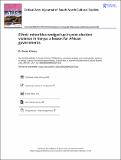| dc.description.abstract | On 27 December 2007, some ten million Kenyans went to the polls in what were generally anticipated to be the most hotly contested and close-run presidential, parliamentary and civic elections in the country’s 45 years since emerging from British colonial rule. The register of voters had been swelled since the previous elections by new registrations, many of them young, first-time voters. The Electoral Commission of Kenya (ECK) had therefore doubled the number of voting stations to 27 555, and arranged in some 20 000 polling centres. President Kibaki trailed most of the time and only started catching up well into the vote tallying exercise. He was ultimately declared the winner (by an extra 231 728 votes over the Orange Democratic Movement’s [ODM] candidate, Raila Odinga) in the late afternoon of 30 December 2007, and then hurriedly sworn in, notwithstanding raucous protests that the results had been rigged … | en_US |

